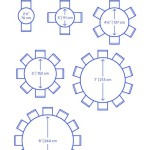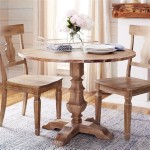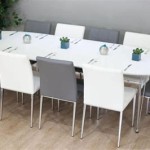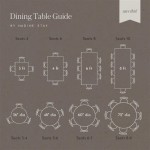Determining the Optimal Diameter for an 8-Person Round Table
Selecting the appropriate size for a round table designed to comfortably accommodate eight individuals requires careful consideration. The table's diameter directly impacts the dining experience, influencing seating comfort, the available space for place settings and serving dishes, and the overall flow of movement within the room. A table that is too small will feel cramped and restrictive, while one that is excessively large may overwhelm the space and hinder conversation. Therefore, determining the ideal diameter involves balancing functionality with aesthetic considerations and spatial constraints.
The primary factor influencing the choice of diameter is the amount of personal space allocated to each diner. This space, often referred to as elbow room, significantly contributes to comfortable dining. Insufficient elbow room can lead to awkward collisions, limited movement, and a generally unpleasant eating experience. Conversely, excessive space may isolate diners and make it difficult to participate in group conversations. Industry standards and ergonomic principles suggest that a minimum of 24 inches of linear space is required per person for comfortable seating at a table.
Beyond personal space, the table's diameter must also accommodate the necessary space for place settings and serving dishes. Each place setting typically requires approximately 18 inches in width. When multiplied by eight diners, this equates to a significant portion of the table's circumference. Furthermore, space is needed in the center of the table for serving dishes, condiments, and decorative items. These items can easily occupy a substantial area, particularly during large gatherings or formal dinners. Neglecting this factor can result in a cluttered table surface and a lack of space for diners to comfortably manage their meals.
The available space within the dining room or designated area where the table will be located is another critical consideration. A table that is too large for the room will impede movement, make the space feel cramped, and potentially create safety hazards. It is essential to measure the room dimensions accurately and consider the placement of other furniture items, such as chairs, sideboards, and cabinets. Ideally, there should be at least 36 inches of clearance between the edge of the table and any walls or other obstacles to allow for comfortable passage and seating access. This clearance should be increased to 48 inches or more if the area is frequently used as a walkway or if individuals using the space have mobility limitations.
Key Point 1: Calculating the Minimum Diameter Based on Seating Space
To calculate the minimum diameter required for an 8-person round table based purely on seating space, one can employ a simple formula. Given the recommendation of 24 inches of linear space per person, the total required circumference can be calculated by multiplying 24 inches by 8, resulting in 192 inches. To determine the diameter, this circumference is divided by pi (π), which is approximately 3.14159. The resulting diameter is approximately 61.1 inches. Therefore, a table with a diameter of at least 61 inches can theoretically accommodate eight individuals with the minimum recommended personal space.
However, it is important to recognize that this calculation provides only a theoretical minimum. In practice, it is generally advisable to add a few inches to this figure to account for variations in chair size, individual body types, and the desire for a more comfortable and less crowded dining experience. Furthermore, this calculation does not factor in the additional space required for place settings and serving dishes, which, as previously mentioned, can significantly impact the overall table surface area needed.
It is also important to consider the effect of the table's base on seating comfort. A central pedestal base may allow for more legroom and flexibility in seating arrangements compared to a table with four legs positioned at the corners. However, even with a pedestal base, the overall diameter must still be sufficient to provide adequate personal space for each diner. When selecting a table with a traditional four-leg design, ensure that the legs are positioned far enough from the edge of the table to avoid obstructing legroom and causing discomfort.
Key Point 2: Accounting for Place Settings and Serving Dishes
The inclusion of place settings and serving dishes necessitates a larger table diameter than the minimum calculated purely based on seating space. A standard place setting, consisting of a dinner plate, cutlery, glassware, and napkins, typically occupies a width of approximately 18 inches. While this width is distributed along the circumference of the table, it still contributes to the overall space required. Furthermore, the center of the table must accommodate serving dishes, which can range in size and quantity depending on the type of meal being served.
To account for place settings and serving dishes, an additional allowance of at least 12 to 18 inches should be added to the minimum diameter calculated previously. This additional space allows diners to comfortably manage their meals without feeling cramped or restricted. It also provides ample room for serving dishes to be placed within easy reach of all diners. Failing to account for this additional space can result in a cluttered table surface and a diminished dining experience.
The style of dining also influences the amount of space required for serving dishes. Formal dinners, which typically involve multiple courses and a wider array of serving dishes, necessitate a larger table diameter than more casual meals. Buffet-style dinners, where diners serve themselves from a central selection of dishes, also require ample space for serving utensils and maneuvering around the table. In such cases, it may be prudent to consider a larger table diameter or to supplement the round table with additional serving surfaces.
Key Point 3: Balancing Diameter with Room Size and Traffic Flow
Even if a table provides ample seating space and accommodates place settings and serving dishes, it is essential to ensure that it fits comfortably within the designated room. A table that is too large for the room will impede movement, make the space feel cramped, and potentially create safety hazards. Before selecting a table diameter, carefully measure the room dimensions and consider the placement of other furniture items, such as chairs, sideboards, and cabinets. Ideally, there should be at least 36 inches of clearance between the edge of the table and any walls or other obstacles.
This clearance allows for comfortable passage around the table and easy access to seating. If the area is frequently used as a walkway or if individuals using the space have mobility limitations, the clearance should be increased to 48 inches or more. In confined spaces, consider using chairs with a smaller footprint or chairs that can be easily tucked under the table when not in use. It is also important to consider the swing radius of doors and the placement of doorways to ensure that the table does not obstruct access to other areas of the room.
The shape of the room also influences the optimal table diameter. In square or rectangular rooms, a round table can help to soften the angles and create a more inviting and conversational atmosphere. However, in narrow or awkwardly shaped rooms, a round table may not be the most efficient use of space. In such cases, a rectangular or oval table may be a more suitable option. Ultimately, the choice of table diameter must be carefully balanced with the room's dimensions, the placement of other furniture items, and the desired flow of movement within the space.
In summary, determining the optimal diameter for an 8-person round table involves considering factors such as individual seating space, space for place settings and serving dishes, and the dimensions of the room in which the table will be placed. By carefully evaluating these considerations, one can select a table that provides a comfortable and functional dining experience while also complementing the aesthetic of the surrounding space.

Round Dining Tables Connecticut In Style Table Dimensions Sizes 8 Person

Tablecloth Size Chart Tavolo Tondo In Resina Arredamento

Dining Table Dimensions Measurements

Creative 8 Person Dining Table Size For Your Eoyment

100 Round Table Seats 8 Diameter Cool Apartment Furniture Check More At Http Livelylighting Dining Sizes Dimensions Kitchen

Dining Table Size
What Size Dining Table Seats 6 Quora

Choose The Right Dining Table West Elm

Revit Family Rectangular Dining Tables Post Digital Architecture

Selected Furniture Tables And Seating Guide








